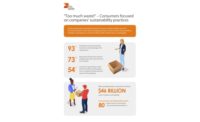DS Smith launches new sustainability strategy - 'Now and Next'
Packaging company reinforces commitment to the circular economy with ambitious two-phase sustainability strategy

DS Smith, a provider of sustainable packaging, has announced the launch of its new sustainability vision and strategy, “Now and Next,” which maps out ambitious commitments and goals for the next decade.
Through its innovative two-phased “Now and Next” approach, DS Smith will continue to focus on the transition to a circular economy by partnering with customers, communities, governments and influencers to keep materials in use, design out waste and regenerate natural systems. It will continue to focus on CO₂ reduction, protecting biodiversity and reducing water consumption.
“As we respond to the changing world in which we live and operate, it is critical that our drive to redefine packaging continues to place circularity at the heart of our business,” said Miles Roberts, group CEO of DS Smith. “Our new strategy allows us to move beyond just having a strong circular business model ourselves to delivering more circular solutions for our customers and the wider society – replacing problem plastics, taking carbon out of supply chains and providing innovative recycling solutions.”
The strategy sets out four key pillars, alongside a continued commitment to reduce CO₂ emissions by 30 percent against a 2015 baseline, and care for its forests and biodiversity wherever it operates. The key areas of the strategy will drive sustainable growth at DS Smith through its ambitious targets:
- Closing the loop through better design – By 2023, it will manufacture 100 percent reusable or recyclable packaging and its aim is that by 2030, all packaging will be recycled or reused.
- Protecting natural resources by making the most of every fiber – By 2025, it will optimize fiber use for individual supply chains in 100 percent of its new packaging solutions and by 2030, it aims to optimize every fiber for all supply chains.
- Reducing waste and pollution through circular solutions – By 2025, it will take 1 billion pieces of problem plastics off store shelves, take 250,000 vehicles off the road and work with partners to find solutions for ‘hard to recycle’ packaging. Meanwhile, by 2030 it aims to use packaging and recycling to enable the circular economy by replacing problem plastics, reducing customer carbon and eliminating consumer packaging waste.
- Equipping people to lead the transition to a circular economy – By 2025 it will engage 100 percent of its employees on the circular economy and by 2030 it will engage 5 million people on the circular economy and circular lifestyles.
“Now and Next positions DS Smith at the forefront of the packaging industry and sets a clear roadmap to address immediate challenges, while also working to meet the needs of the next generation by creating solutions that are aligned with the principles of the circular economy,” said Wouter van Tol, head of sustainability, community and government affairs for DS Smith. “By taking a whole systems approach, we have a huge opportunity to make significant progress against our environmental, social and governance responsibilities.”
After measurable progress against its nine long-term sustainability goals, the “Now and Next Sustainability Strategy” has been introduced as part of a strategic review and vision to be the leading supplier of sustainable packaging. In the past year, DS Smith met a number of sustainability milestones, including an 11 percent reduction in emissions in 2019 compared to 2015 on a like-for-like basis and 100 percent engagement in community programs across its sites employing more than 50 people.
An international packaging company, it produced over 17 billion boxes in 2019/20 and is Europe’s largest cardboard and paper recycler, managing 6 million tons per year, making it a net positive recycler. DS Smith is one of only 16 Strategic Partners of the Ellen MacArthur Foundation—the recognized global authority on the circular economy.
Looking for a reprint of this article?
From high-res PDFs to custom plaques, order your copy today!







